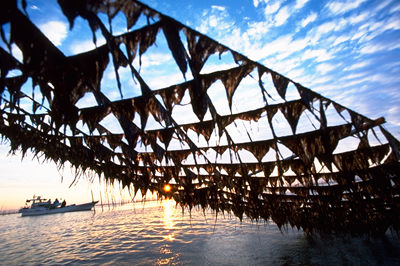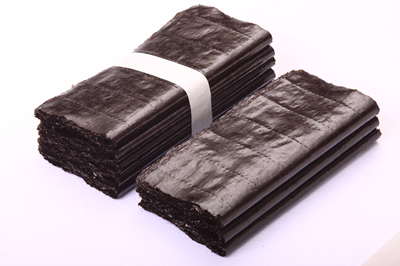
Although the word "nori" may be unfamiliar to many, anyone who has been to a sushi restaurant or taken a look at ready made sushi in a shop is more than likely to have come across this staple Japanese food. Nori, sometimes called "laver" is the dark strip of dried seaweed wrapped around "maki" or roll sushi, and the cone that contains the rice and filling of "temaki" sushi hand rolls. When sushi was first introduced to the West, chefs devised the "uramaki" or inside-out sushi rolls which hid the nori as dried seaweed was thought to be a step too far for the western palate. These days, sushi is hugely popular worldwide and, nori is now back to the fore not only in the sushi bar, but as both an important ingredient in the fusion chef's kitchen and as a snack by itself.
Nori has also been attracting attention for its nutritional properties. It is a fat-free, alkaline food, high in fibre, protein and antioxidants. As well as containing various vitamins, minerals and iron, it is a rich source of iodine, which is essential important in hormone development, and a single sheet of nor contains the same amount of calcium as 20cc of milk or one egg. As it is also virtually calorie free, it is hardly surprising that it is often touted as a "superfood".

Nori, a kind of red algae that turns dark green when dried, has been eaten in Japan for more than two thousand years. For much of this time, the harvest was limited to what could be pulled from rocks at low tide. It was a highly prized, expensive food enjoyed by the Japanese nobility.
It was in the Edo-era, when what we might recognize as today's nori, was developed. The governing Tokugawa Shogunate saw the revenue potential of nori and began cultivation on nets in Tokyo Bay. Soon, dozens of times the volume of nori hitherto produced was reaching markets and nori began to make its way from the banquets of the rich into the hands, and stomachs, of the masses. It was during this time that nori began to be formed into dried sheets using methods similar to those used in Japanese paper-making.
The life cycle of nori was still, however, a mystery. The algae didn't seem to have any seeds, growers were forced to rely on luck, yields were unpredictable, and prices remained high. It wasn't until 1949 that the reproductive process of nori was discovered by a British botanist named Kathleen Drew-Baker. Her discovery made predictable and efficient cultivation of nori possible. This sowed the seeds, or spores to be exact, of a 2 billion dollar industry. A monument in honor of Drew-Baker stands on the Ariake coast in Kumamoto Prefecture overlooking Japan's top nori production area. Drew-Baker's work is also commemorated by those in the industry every year on April 14.
















